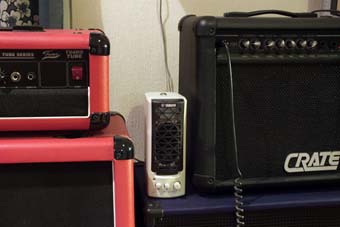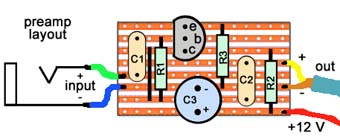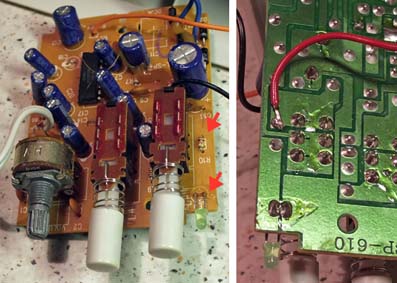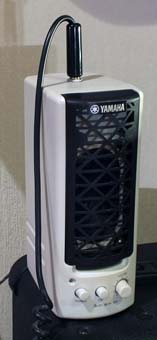Diy mini amplifier for guitar
 The
easiest way to build a mini amplifier is to modify a powered PC speaker
by adding a simple preamplifier. And you can do this very cheaply. I
bought my speaker set from a flea market for two euros!
The
easiest way to build a mini amplifier is to modify a powered PC speaker
by adding a simple preamplifier. And you can do this very cheaply. I
bought my speaker set from a flea market for two euros!
Small size was my main priority but the box should have room for the
preamplifier. Itīs also important that the box contains all electronics
(mains transformer and amplifier board). Some sets have the transformer
in the other speaker box.
I wanted an amplifier at my workbench. It would be handy when working
with guitar electronics and this little box seems to do the job better
than I expected. And it doesnīt take much space on the shelf.
 This
preamp circuit is probably the simpliest you can find. Transistor
2N3904 is very common and easily available but many others would do as
well (just check the pinout).
This
preamp circuit is probably the simpliest you can find. Transistor
2N3904 is very common and easily available but many others would do as
well (just check the pinout).
Emitter resistor R3 controls the gain, smaller value would give you more gain but I was happy with 270 ohms.
Smoothing capacitor C3 is here because it is a good practice to have
one. You could probably leave that out to save space if thatīs an issue.
A small circuit like this is easy to assemble on a piece of veroboard
(stripboard). I didnīt have any so I placed all components on a piece
of plastic and made the connections backside "point to point" style.
 I
planned this layout anyway just in case someone might need one. Note
that I havenīt actually tried this - hopefully I didnīt make any
mistakes!
I
planned this layout anyway just in case someone might need one. Note
that I havenīt actually tried this - hopefully I didnīt make any
mistakes!
 You
have to attach the preamp somewhere. I simply bolted the board to input
jack terminal. Stiff ground wire supports the board at other corner.
You
have to attach the preamp somewhere. I simply bolted the board to input
jack terminal. Stiff ground wire supports the board at other corner.
I used speakerīs fixed input cable to connect my preamp to the main
board (shielded grey cable at right). Since the preamp gets ground
connection via that cable I only needed a positive supply voltage
somewhere (red wire).
Disconnect the speaker from mains before opening the box! I have done
that mistake a couple of times in the past - itīs not nice to stick
your fingers to 230 volts AC, believe me!
 The
best place to find supply voltage is somewhere near the power on led at
the main circuit board. Normally one led terminal is at ground and
other is connected to supply voltage via a series resistor. That
resistor should be easy to find if you follow the traces from the led.
The
best place to find supply voltage is somewhere near the power on led at
the main circuit board. Normally one led terminal is at ground and
other is connected to supply voltage via a series resistor. That
resistor should be easy to find if you follow the traces from the led.
Easy job in this case. Perhaps you can also see how the supply voltage goes to power switch terminals - another good hint.
To be sure I wanted to measure the voltage before making any
connections. Mains transformer and other dangerous things were in a
safe place inside the box so it was ok to power up the system in this
condition. I measured the voltage between the "upper" end of the
resistor marked in the picture and the - terminal of the speaker (it is
usually connected to ground). + 12,6 V, perfect!. Anything from 6 to 15
volts should be ok.
Next I pulled off the mains plug (!) and started to put the thing together.
 I
installed the input jack (with the preamp) on top for two reasons.
First, there was room for the preamp and second, it is possible to
connect the guitar cable with one hand without turning the amp over.
I
installed the input jack (with the preamp) on top for two reasons.
First, there was room for the preamp and second, it is possible to
connect the guitar cable with one hand without turning the amp over.
Finally I enhanced the looks by tearing off ugly foam that was hiding a
very professional looking speaker grille. I also added a Yamaha logo
that was laying around.
So, how does it sound? Well, not bad at all considering the starting
point. When connected straight to a guitar it certainly works for my
original purpose. To find out how it would do as a practice amp I put
it behind my pedalboard. I started to go through factory presets of my
old Digitech RP50 multieffect. So far Iīve found those to be mostly
useless with a "real" amp but this time most presets sounded pretty
decent, especially more acoustic/ambient effects. Overdrive sounds were
mostly ok but anything beyond AC/DC started to sound crappy. You donīt
want to play death metal with this amp.
The quality of the original speaker defines the end result, of course.
A preamp doesnīt make it sound any better. This little thing cannot
replace a real guitar amplifier but I think it would be good enough for
low volume practicing without disturbing other family members. A
headphones output might be useful to somebody, mine does not have one.
Value for money is hard to beat! Thereīs a lot of amp for two euros!
ĐJukka Korppi 2015


 The
easiest way to build a mini amplifier is to modify a powered PC speaker
by adding a simple preamplifier. And you can do this very cheaply. I
bought my speaker set from a flea market for two euros!
The
easiest way to build a mini amplifier is to modify a powered PC speaker
by adding a simple preamplifier. And you can do this very cheaply. I
bought my speaker set from a flea market for two euros! This
preamp circuit is probably the simpliest you can find. Transistor
2N3904 is very common and easily available but many others would do as
well (just check the pinout).
This
preamp circuit is probably the simpliest you can find. Transistor
2N3904 is very common and easily available but many others would do as
well (just check the pinout). I
planned this layout anyway just in case someone might need one. Note
that I havenīt actually tried this - hopefully I didnīt make any
mistakes!
I
planned this layout anyway just in case someone might need one. Note
that I havenīt actually tried this - hopefully I didnīt make any
mistakes! You
have to attach the preamp somewhere. I simply bolted the board to input
jack terminal. Stiff ground wire supports the board at other corner.
You
have to attach the preamp somewhere. I simply bolted the board to input
jack terminal. Stiff ground wire supports the board at other corner. The
best place to find supply voltage is somewhere near the power on led at
the main circuit board. Normally one led terminal is at ground and
other is connected to supply voltage via a series resistor. That
resistor should be easy to find if you follow the traces from the led.
The
best place to find supply voltage is somewhere near the power on led at
the main circuit board. Normally one led terminal is at ground and
other is connected to supply voltage via a series resistor. That
resistor should be easy to find if you follow the traces from the led. I
installed the input jack (with the preamp) on top for two reasons.
First, there was room for the preamp and second, it is possible to
connect the guitar cable with one hand without turning the amp over.
I
installed the input jack (with the preamp) on top for two reasons.
First, there was room for the preamp and second, it is possible to
connect the guitar cable with one hand without turning the amp over.

